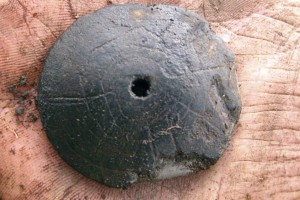 Archaeologists documenting unusual petroglyphs in the Noatak National Preserve in Northwest Alaska have discovered four prehistoric engraved clay disks that are the first such artifacts ever found in Alaska.
Archaeologists documenting unusual petroglyphs in the Noatak National Preserve in Northwest Alaska have discovered four prehistoric engraved clay disks that are the first such artifacts ever found in Alaska.
Rock art of any kind is rare in Interior and Northern Alaska. The Noatak petroglyphs are engraved on the foundation stones of prehistoric house pits on the shore of Feniak Lake. Archaeologists found them 40 years ago but then left them undocumented. This summer, a multidisciplinary team of artists and archaeologists from the University of Alaska Museum of the North and the National Park Service went to Noatak to sketch and trace all the petroglyphs on site.
During small-scale excavations in the shallow depressions that mark the remains of prehistoric dwellings, Scott Shirar, a research archaeologist with the UA museum of the North, and his colleagues made an exciting discovery. They found four clay disks decorated with lines, grooves and perforations.
“The first one looks like a little stone that had some scratch marks on it,” Shirar said. “We got really excited when we found the second one with the drilled hole and the more complicated etchings on it. That’s when we realized we had something unique.”
After collaborating with experts and looking up examples in the archaeological record, Shirar said the disks appear to be a new artifact type for Alaska. “We only opened up a really small amount of ground at the site, so the fact that we found four of these artifacts indicates there are probably more and that something really significant is happening.”
The disks have yet to be dated officially. They are at the University of Alaska Museum of the North where they will be analyzed and studied further. Preliminary dating based on the features of the ancient dwellings and other observable data suggests the settlement and clay disks date to the late prehistoric era, approximately a thousand years ago. Radiocarbon dating on organic matter recovered during the excavation will provide more detail.
Feniak Lake is about 100 miles northeast of the Inupiat Eskimo community of Kotzebue. Despite the Arctic climate, the location has been populated for 11,000 years, which means people settled there in the first immigrant wave to cross the Bering land bridge between 16,000 and 10,000 B.C.